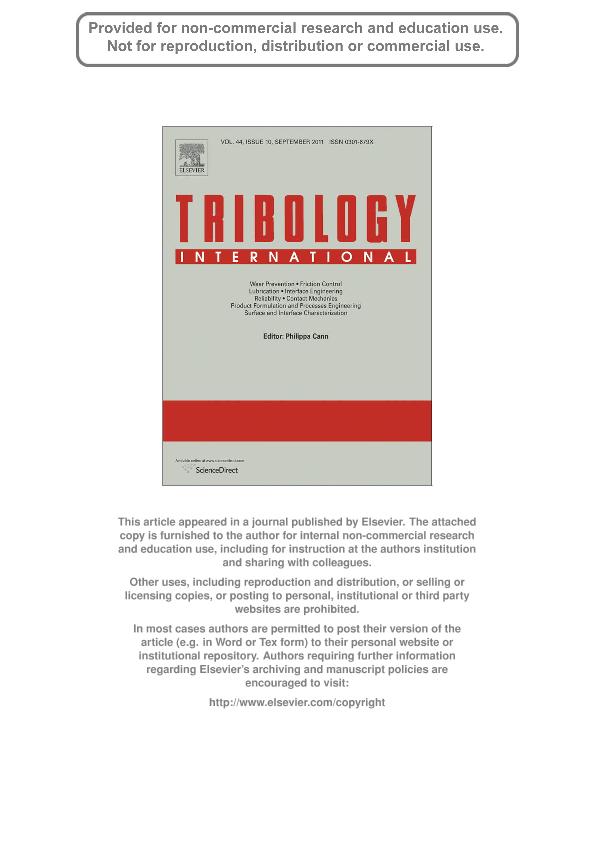Mostrar el registro sencillo del ítem
dc.contributor.author
Vignolo, Gustavo Gabriel

dc.contributor.author
Barilá, Daniel O.
dc.contributor.author
Quinzani, Lidia Maria

dc.date.available
2018-08-17T17:58:11Z
dc.date.issued
2011-09
dc.identifier.citation
Vignolo, Gustavo Gabriel; Barilá, Daniel O.; Quinzani, Lidia Maria; Approximate analytical solution to Reynolds equation for finite length journal bearings; Elsevier; Tribology International; 44; 10; 9-2011; 1089-1099
dc.identifier.issn
0301-679X
dc.identifier.uri
http://hdl.handle.net/11336/56209
dc.description.abstract
The understanding of the behavior of hydrodynamic bearings requires the analysis of the fluid film between two solid surfaces in relative motion. The differential equation that governs the movement of this fluid, called the Reynolds equation, arises from the integration over the film thickness of the continuity equation, previously combined with the NavierStokes equation. An order of magnitude analysis, which is based on the relative value of the dimensions of the bearing, produces two dimensionless numbers that govern the behavior of the system: the square of the aspect ratio, length over diameter (L/D)2, and the eccentricity ratio (η). An analytical solution of the Reynolds equation can only be obtained for particular situations as, for example, the isothermal flow of Newtonian fluids and values of L/D→0 or L/D→∞. For other conditions, the equation must be solved numerically. The present work proposes an analytical approximate solution of the Reynolds equation for isothermal finite length journal bearings by means of the regular perturbation method. (L/D)2 is used as the perturbation parameter. The novelty of the method lays in the treatment of the Ocvirk number as an expansible parameter. The zero-order solution of the Reynolds equation (obtained for L/D→0), which matches the Ocvirk solution, may be used to describe the behavior of finite length journal bearings, up to L/D∼1/81/4, and relatively small eccentricities. The first-order solution obtained with the proposed method gives an analytical tool that extends the description of pressure and shear-stress fields up to L/D∼1/2 and η∼1/2 (or combinations of larger eccentricities with smaller aspect ratios, or vice versa). Moreover, the friction force and load-carrying capacity are accurately described by the proposed method up to L/D∼1 and η very near to 1.
dc.format
application/pdf
dc.language.iso
eng
dc.publisher
Elsevier

dc.rights
info:eu-repo/semantics/openAccess
dc.rights.uri
https://creativecommons.org/licenses/by-nc-nd/2.5/ar/
dc.subject
Hydrodynamic Lubrication
dc.subject
Journal Bearings
dc.subject
Regular Perturbation
dc.subject
Reynolds Equation
dc.subject.classification
Otras Ingeniería Química

dc.subject.classification
Ingeniería Química

dc.subject.classification
INGENIERÍAS Y TECNOLOGÍAS

dc.title
Approximate analytical solution to Reynolds equation for finite length journal bearings
dc.type
info:eu-repo/semantics/article
dc.type
info:ar-repo/semantics/artículo
dc.type
info:eu-repo/semantics/publishedVersion
dc.date.updated
2018-07-11T13:59:57Z
dc.journal.volume
44
dc.journal.number
10
dc.journal.pagination
1089-1099
dc.journal.pais
Países Bajos

dc.journal.ciudad
Amsterdam
dc.description.fil
Fil: Vignolo, Gustavo Gabriel. Consejo Nacional de Investigaciones Científicas y Técnicas. Centro Científico Tecnológico Conicet - Bahía Blanca. Planta Piloto de Ingeniería Química. Universidad Nacional del Sur. Planta Piloto de Ingeniería Química; Argentina
dc.description.fil
Fil: Barilá, Daniel O.. Universidad Nacional de la Patagonia; Argentina
dc.description.fil
Fil: Quinzani, Lidia Maria. Consejo Nacional de Investigaciones Científicas y Técnicas. Centro Científico Tecnológico Conicet - Bahía Blanca. Planta Piloto de Ingeniería Química. Universidad Nacional del Sur. Planta Piloto de Ingeniería Química; Argentina
dc.journal.title
Tribology International

dc.relation.alternativeid
info:eu-repo/semantics/altIdentifier/doi/http://dx.doi.org/10.1016/j.triboint.2011.03.020
dc.relation.alternativeid
info:eu-repo/semantics/altIdentifier/url/https://www.sciencedirect.com/science/article/pii/S0301679X11000752
Archivos asociados
